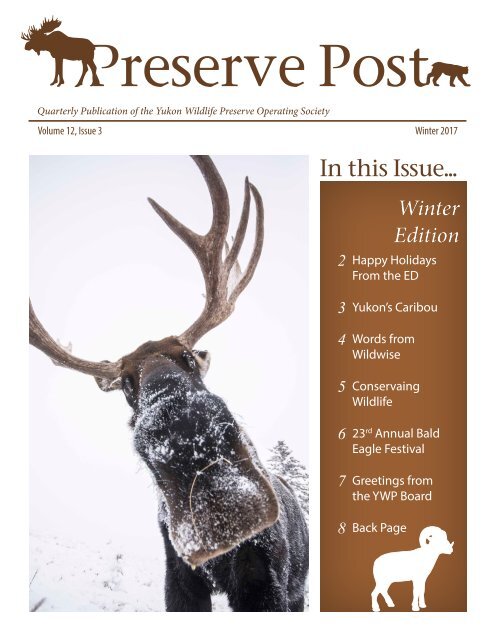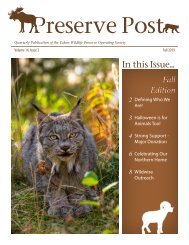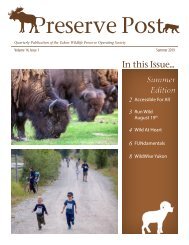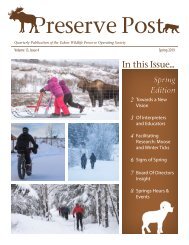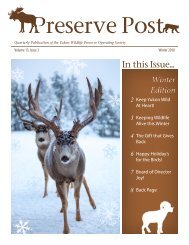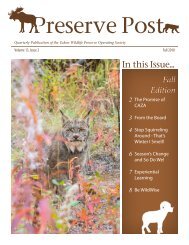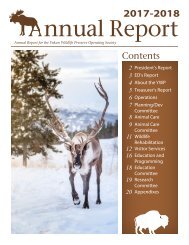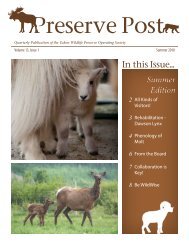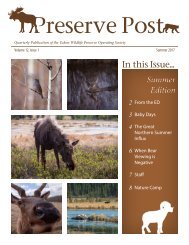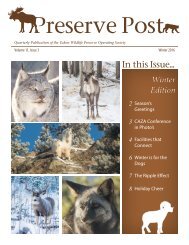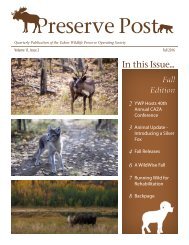2017 Winter Newsletter Email and Digital No Block
Happy Holidays! Enjoy articles from some of our staff, board, and partners. We are forever grateful for our community of YWP supporters!
Happy Holidays! Enjoy articles from some of our staff, board, and partners. We are forever grateful for our community of YWP supporters!
You also want an ePaper? Increase the reach of your titles
YUMPU automatically turns print PDFs into web optimized ePapers that Google loves.
Quarterly Publication of the Yukon Wildlife Preserve Operating Society<br />
Volume 12, Issue 3<br />
<strong>Winter</strong> <strong>2017</strong><br />
In this Issue...<br />
2 Happy Holidays<br />
From the ED<br />
3 Yukon’s Caribou<br />
4 Words from<br />
Wildwise<br />
5 Conservaing<br />
Wildlife<br />
6 23 rd Annual Bald<br />
Eagle Festival<br />
7 Greetings from<br />
the YWP Board<br />
8 Back Page<br />
<strong>Winter</strong><br />
Edition
Season’s Greetings from the<br />
Wildlife Preserve!<br />
Happy holidays <strong>and</strong> wishes to all for a safe <strong>and</strong><br />
adventurous new year. If you’re like me, it feels like I<br />
was just saying this a little while ago – not a full year<br />
ago!<br />
Since Christmas 2016, the Wildlife Preserve has<br />
enjoyed substantial increases in visitation numbers<br />
from all market segments. Daily visitors – whether<br />
local Yukon residents or visiting tourists, both have<br />
been attending the Preserve in ever stronger numbers.<br />
Our Travel Trade partners have also experienced a<br />
banner year with record-setting numbers of in-bound<br />
group travel packages <strong>and</strong> our Exclusive Experience<br />
program continues to gain popularity.<br />
This is in keeping with most of our tourism colleagues<br />
throughout the Territory. As Neil Hartling, Chair of<br />
TIA Yukon recently stated: “This past year has been<br />
incredibly successful for tourism in the Yukon – some<br />
have even gone so far to say that <strong>2017</strong> was a record<br />
year … Based on its discussions with the industry, TIA<br />
Yukon asserts that visitor numbers <strong>and</strong> spending will<br />
continue to be strong in 2018”.<br />
Our improved visitation <strong>and</strong> revenue numbers are a<br />
direct result of community support, <strong>and</strong> for<br />
this we are eternally grateful! The Preserve<br />
belongs to all people of the Yukon <strong>and</strong> we<br />
are honoured to provide you with quality,<br />
experiential wildlife viewing <strong>and</strong> learning<br />
opportunities.<br />
A tremendous thank you is extended to our<br />
very generous community, our supporters,<br />
suppliers, partners, <strong>and</strong> volunteers.<br />
Wishing everyone a wonderful holiday<br />
season!<br />
Executive Director,<br />
Yukon Wildlife Preserve<br />
Cover photo: Male moose poses for a very cartoonlike<br />
photo.<br />
2<br />
Top Left: Our red fox, who will turn 4 years old in the spring, is a striking contrast<br />
to the snowy, winter l<strong>and</strong>scape.<br />
Volume 12, Issue 3
Connecting Youth to Yukon’s Caribou<br />
Seeing the Yukon Ice Patches featured in the<br />
The Nature of Things on CBC was exciting –<br />
especially the updates on Kwäday Dän Ts’ìnchi<br />
(Long Ago Man Found) <strong>and</strong> the finding of a<br />
locally sourced metal arrow tip.<br />
We’d been working on updating our grade 7<br />
Caribou program already, so it was a perfect<br />
time to incorporate these new developments.<br />
If a class trip to the Preserve says “biology” to<br />
you – you’re not alone. But the animals at the<br />
Preserve are much more than their biology.<br />
They have rich cultural heritage <strong>and</strong> a long<br />
relationship with humans. Luckily, a new<br />
curriculum hit classrooms this fall. It puts the<br />
focus on locally relevant stories <strong>and</strong> blend<br />
biology, culture, social issues, math <strong>and</strong> more!<br />
Tag along with a grade 7 class this fall <strong>and</strong> you’d find yourself diving into a 1.6million year history that explores<br />
the evolution of Caribou <strong>and</strong> especially our relationship with caribou over the last 24,000 years – from traditional<br />
stories to modern<br />
population sampling<br />
techniques. Throwing<br />
atlatls gives students firsth<strong>and</strong><br />
experience with the<br />
Yukon’s rich snow patch<br />
history. And of course we<br />
explore the many threats<br />
caribou facing <strong>and</strong> the<br />
complexity in managing<br />
those challenges.<br />
If it sounds like a lot, it is!<br />
But by keeping the focus<br />
on h<strong>and</strong>s-on, tangible<br />
activities, students are able<br />
to tackle some challenging<br />
ideas <strong>and</strong> really enjoy<br />
some of the richness that<br />
Caribou give to life in the<br />
Yukon.<br />
<strong>Winter</strong> <strong>2017</strong><br />
Top Right: Students hike through the caribou enclosure to see evolution up close.<br />
Bottom: Students experience Yukon Ice Patch history by learning to use atlatls.<br />
3
Letting Sleeping Bears Rest<br />
We are very relieved for the bears<br />
this December, assuming they<br />
have gone to sleep, that is. <strong>2017</strong><br />
proved to be a pretty tough year to<br />
be a bear anywhere in the Yukon<br />
Territory. Environment Yukon<br />
reports that they have records of 63<br />
bears being killed due to humanwildlife<br />
conflict this season. What<br />
we don’t know is how many are<br />
being killed <strong>and</strong> not being reported,<br />
which makes determining bear<br />
populations <strong>and</strong> harvest quotas<br />
pretty hard to determine. The<br />
great thing about bears is that they<br />
are extremely tolerant relative<br />
to humans <strong>and</strong> most of them will<br />
move on before they are relocated<br />
or destroyed. Busy, busy, busy<br />
bears, always looking for food so<br />
their offspring will survive.<br />
WildWise Yukon is a relatively new<br />
organization <strong>and</strong> we are still on a<br />
fact finding mission, recognizing<br />
that an evidence based approach<br />
is the way to go. This summer<br />
we went door to door in rural<br />
residential neighborhoods,<br />
in Copper Ridge <strong>and</strong> in<br />
Carmacks. We offered to<br />
survey properties for bear<br />
attractants <strong>and</strong> give simple<br />
suggestions for improving<br />
safety <strong>and</strong> decreasing the<br />
likelihood of human-wildlife<br />
conflict. It has taken us a<br />
while to recognize what we<br />
learned from this outreach<br />
initiative but we are confident<br />
now that we have learned<br />
enough to guide our next<br />
mission, which is to find out<br />
why some people don’t seem<br />
to care much about making<br />
the wilderness safer for bears<br />
<strong>and</strong> humans <strong>and</strong> how their<br />
perception of risk shapes the<br />
decisions they make.<br />
All this to say, please keep<br />
in touch to find out what we<br />
will be doing in the coming<br />
year. With an Environment Grant<br />
from the City of Whitehorse we<br />
will be researching what is working<br />
in other places. We will also be<br />
working with Environment Yukon<br />
to find out how to reach out to<br />
tourists <strong>and</strong> wilderness tourism<br />
operators to reduce the negative<br />
impacts that they may unknowingly<br />
have on bears <strong>and</strong> communities<br />
that live with bears. And we will<br />
keep working on education <strong>and</strong><br />
outreach for people of all ages<br />
throughout the territory. Please<br />
visit our website where we publish<br />
all of our findings <strong>and</strong> update your<br />
access to information on a regular<br />
basis.<br />
Heather Ashthron is the Executive<br />
Director of Wildwise Yukon. For<br />
more information about this <strong>and</strong><br />
other iniatives to reducing humanwildlife<br />
conflict visit<br />
www.wildwise.ca or give us a call at<br />
335-5212.<br />
We would be happy to hear from<br />
you!<br />
Above: Polycarts, used in Whitehorse city limits garbage disposal <strong>and</strong> collection<br />
program, are an easily acessible <strong>and</strong> often very rewarding attractant for bears.<br />
4<br />
Volume 12, Issue 3
Conserving Wildlife<br />
When you think about predator<br />
prey relationships, which two<br />
animals comes to mind first?<br />
Perhaps we think about the cheetah<br />
<strong>and</strong> a gazelle racing against each<br />
other across the African Savannah,<br />
or maybe the feud between Tom<br />
<strong>and</strong> Jerry, the household battle of<br />
cat <strong>and</strong> mouse, comes to mind.<br />
In the Yukon Wildlife Preserve<br />
l<strong>and</strong>scape, another member of<br />
the feline family pits it’s powerful<br />
predatory nature against a speedy<br />
<strong>and</strong> camouflaged target.<br />
The lynx <strong>and</strong> snowshoe hare have<br />
a long <strong>and</strong> highly intertwined<br />
relationship. A long history of<br />
trapping, about 200 years worth,<br />
has shown closely linked 10-year<br />
cycles of growth <strong>and</strong> decline in<br />
populations of the two species.<br />
A picky eater, the lynx’s diet is<br />
comprised of about 75% snowshoe<br />
hare creating a boom <strong>and</strong> bust<br />
cycle. When hare populations drop,<br />
the lynx populations also drop<br />
shortly after. This, along with other<br />
threats, jeopardizes the genetic<br />
integrity <strong>and</strong> overall demographic<br />
stability of the predator.<br />
Recognizing this species’ potential<br />
peril, special efforts began across<br />
the north american zoological<br />
world to actively manage captive<br />
populations of sensitive species.<br />
The Species Survival Plan (SSP)<br />
program was developed in 1981 to<br />
cooperatively manage select species<br />
in captivity in order to enhance the<br />
conservation of these species in<br />
the wild. The program was started<br />
through the Association of Zoo’s<br />
<strong>and</strong> Aquariums (AZA) <strong>and</strong> is<br />
further facilitated <strong>and</strong> participated<br />
in by related<br />
organizations<br />
<strong>and</strong> conservation<br />
partners<br />
including Canada<br />
Accredited Zoo’s<br />
<strong>and</strong> Aquarium<br />
(CAZA) facilities<br />
like the Yukon<br />
Wildlife Preserve<br />
(YWP).<br />
YWP participates<br />
in this program<br />
through breeding<br />
<strong>and</strong> transferring<br />
of individuals. For almost 15 years<br />
our male lynx on display, originally<br />
from the wild, provided unique<br />
genetics in breeding <strong>and</strong> producing<br />
offspring that were subsequently<br />
rehomed to other facilities across<br />
<strong>No</strong>rth America.<br />
When lynx populations decline<br />
<strong>and</strong> genetic diversity is limited<br />
YWP <strong>and</strong> other facilities help play<br />
an important conversation role<br />
within the Species Survival Plan<br />
program. By maintaining healthy<br />
<strong>and</strong> genetically diverse captive<br />
lynx populations, the long-term<br />
conservation of species with<br />
uncertain futures is improved.<br />
<strong>Winter</strong> <strong>2017</strong><br />
Top Right: Species Survival Plan logo depicting a rhino <strong>and</strong> offspring - we can<br />
look to our own backyard for animals that might also need greater efforts through<br />
conservation programs. Bottom Right: <strong>Winter</strong> white snowshoe hare. Bottom Left:<br />
Originally from the wild, this male lynx is 20 years old <strong>and</strong> gentically, very viable.<br />
5
Reflecting on the 23 rd Annual Alaska<br />
Bald Eagle Festival, Haines<br />
In early <strong>No</strong>vember, the American<br />
Bald Eagle Foundation was proud<br />
to host the 23 rd annual Alaska Bald<br />
Eagle Festival in Haines, Alaska.<br />
The festival is a celebration of one<br />
of the world’s largest congregations<br />
of bald eagles. Historically, as<br />
many as four thous<strong>and</strong> eagles have<br />
gathered in the Alaska Chilkat<br />
Bald Eagle Preserve, specifically<br />
concentrated on a five mile stretch<br />
at the confluence of the Klehini,<br />
Tsirku, <strong>and</strong> Chilkat rivers. The<br />
eagles are attracted to this area<br />
by the availability of spawning<br />
salmon which are accessible<br />
because the stretch of the river<br />
remains unfrozen, while other<br />
nearby watersheds are typically<br />
frozen. Food is scarce elsewhere,<br />
which brings birds from all over<br />
Alaska, Yukon Territory, <strong>and</strong><br />
British Columbia to partake in the<br />
unseasonal feast.<br />
The river is also a draw for tourists<br />
<strong>and</strong> bird enthusiasts from all<br />
over the world who travel to<br />
Haines to witness the gathering.<br />
Each year, ABEF hosts a weeklong<br />
festival focused on sharing<br />
science, culture, <strong>and</strong> conservation<br />
with these travelers. This year’s<br />
highlights included a presentation<br />
by researcher Rachel Wheat,<br />
PhD discussing her<br />
research on the bald<br />
eagles of the Chilkat<br />
valley, an evening<br />
of story telling with<br />
members of nearby<br />
Tlingit village<br />
Klukwan, <strong>and</strong> an<br />
evening of raptor<br />
trivia hosted by the<br />
ABEF staff. The week<br />
culminated with the<br />
release of two subadult<br />
bald eagles who<br />
had been rehabilitated at the Bird<br />
Treatment <strong>and</strong> Learning Center in<br />
Anchorage, Alaska. The eagles were<br />
released on the river flats near the<br />
Jilkaat Kwaan Heritage Center in<br />
Klukwan by two lucky individuals<br />
who had the winning bids for the<br />
honor. Proceeds from the auction<br />
support the work of the ABEF <strong>and</strong><br />
Bird TLC.<br />
Sidney Campbell is the Education <strong>and</strong> Outreach Coordinator at the American Bald Eagle<br />
Foundation in Haines, Alaska. She works to bring empowering wildlife education to Haines <strong>and</strong><br />
surrounding communities by managing outreach, publications, <strong>and</strong> educational programming.<br />
She works with the Raptor Program Manager to train the avian ambassadors at the facility to<br />
take part in education <strong>and</strong> outreach.<br />
Visit the American Bald Eagle Foundation in Haines, Alaska. The facility is currently open<br />
Monday to Friday’s 10am - 3pm. Closed Saturday <strong>and</strong> Sundays.<br />
6<br />
Bottom Left:. The sub-adult seconds after release flies past the Jilkaat Kwaan<br />
Heritage Center <strong>and</strong> a crowd of onlookers Top Right: Sub-adult bald eagle,<br />
rehabilitated at the Bird Treatment <strong>and</strong> Learning Center, released by auction<br />
winner Nancy Hamoud.Photos: Bill McRoberts - Field2Frame Photography.<br />
Volume 12, Issue 3
Greetings from the Board<br />
How I came to the Yukon is<br />
the classic story. My family<br />
<strong>and</strong> I travelled to the territory<br />
for a summer of work, <strong>and</strong><br />
we’ve been here coming up<br />
on three years. What is not to<br />
love about the Yukon? While<br />
the winters may be long, they<br />
are stunningly beautiful <strong>and</strong><br />
getting outside to play is just<br />
so wonderfully accessible. And<br />
accessibility matters when<br />
you have two children under<br />
4-years old! I figured the best<br />
way to get involved in my new<br />
community was to become<br />
a board member. Given my<br />
previous work experience;<br />
as a park interpreter, a<br />
zookeeper at the Calgary<br />
Zoo for 10 years <strong>and</strong> then an<br />
environmental consultant;<br />
the Yukon Wildlife Preserve<br />
seemed the perfect fit. I was<br />
thrilled they welcomed me<br />
into the fold. Yukoners may<br />
not realize the jewel they<br />
have here at the Preserve. The<br />
ability to house large social<br />
groupings of native species in<br />
stunning, natural l<strong>and</strong>scapes<br />
makes YWP the envy of most<br />
zoological facilities. This<br />
makes for exceptionally happy<br />
<strong>and</strong> healthy animals. The tours<br />
<strong>and</strong> environmental education<br />
programming are impressive<br />
(be sure to check them out!).<br />
YWP is steadily getting better<br />
<strong>and</strong> better. I am excited to<br />
be a part of the team that is<br />
working to make the Preserve<br />
a place for everyone in our<br />
community to learn <strong>and</strong> enjoy.<br />
Cheers,<br />
Shawna Warshawski<br />
Vice-President, Yukon<br />
Wildlife Preserve<br />
Operating Society<br />
Full-time Staff<br />
Yukon<br />
Wildlife<br />
Preserve<br />
Greg Meredith, Executive Director<br />
R<strong>and</strong>y Hallock, Director of Outdoor<br />
Operations<br />
Dr. Maria Hallock, Wildlife<br />
Veterinarian <strong>and</strong> Curator<br />
Jake Paleczny, Director of<br />
Programming & Education<br />
Lindsay Caskenette, Manager of<br />
Visitor Services<br />
Briana Van Den Bussche, Senior<br />
Education Programmer<br />
Board of Directors<br />
Alex<strong>and</strong>ra Tait President<br />
Shawna Warshawski, 1 st Vice-<br />
President<br />
Michael Kokiw, 2 nd Vice-President,<br />
Kristine Hildebr<strong>and</strong>, Treasurer<br />
Jessie Dawson<br />
Chris Evans<br />
Katelyn Friendship<br />
Kirk Cameron<br />
Shirley Adamson<br />
Ed van R<strong>and</strong>en <strong>No</strong>n-voting Member<br />
- Environment Yukon<br />
Darrell March, <strong>No</strong>n-voting Member -<br />
Environment Yukon<br />
Bottom Left: Animals in captivitiy greatly benefit from a veterinary health care<br />
program. Shawna checks the hippos teeth <strong>and</strong> the hippo enjoys a gum massage in<br />
the process. Top Right: Out for a hike in the beautiful Yukon with Family.<br />
<strong>Winter</strong> <strong>2017</strong><br />
7
Happy holidays from all the creatures at the<br />
Yukon Wildlife Preserve!<br />
When to Visit<br />
<strong>Winter</strong> Hours<br />
10:30am to 4:00pm: Friday to Sunday’s<br />
Guided Bus Tours at 12pm & 2pm.<br />
Walk, run, bike anytime while open. Enjoy a safe,<br />
relaxed environment for the whole family!<br />
Dasher!<br />
Is that you?<br />
Extended Holiday Hours<br />
Open daily from Dec 26 th to Jan 2 nd<br />
10:30am to 4:00pm.<br />
Guided Bus tours at 12pm & 2pm<br />
Curious about the latest news? Visit<br />
facebook.com/yukonwildlife or call 456-7300.<br />
We’re Social - join us on Instragram!<br />
Share your adventures <strong>and</strong> we`ll re-share our favs!<br />
Tag us #YukonWildlife<br />
Writing: Lindsay Caskenette, Greg Meredith,<br />
8<br />
Sidney Campbell, Jake Paleczny, Heather Ashthorn, Shawna<br />
Warshawski.<br />
Photos <strong>and</strong> illustrations: Lindsay Caskenette, Jake Paleczny,<br />
Shawna Warshawski, Bill McRoberts, Heather Ashthorn.<br />
Printed on 100% Recycled Volume Paper 12, Issue 3


